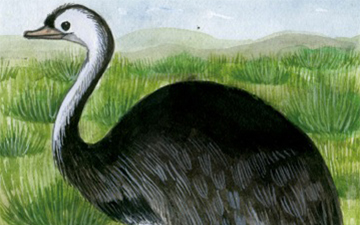The lesser rhea stands at 90 to 100 cm (35–39 in) tall. Length is 92 to 100 cm (36–39 in) and weight is 15 to 28.6 kg (33–63 lb).[2][5] Like most ratites, it has a small head and a small bill, the latter measuring 6.2 to 9.2 cm (2.4 to 3.6 in), but has long legs and a long neck. It has relatively larger wings than other ratites, enabling it to run particularly well. It can reach speeds of 60 km/h (37 mph), enabling it to outrun predators. The sharp claws on the toes are effective weapons. Their feathers are similar to those of ostriches, in that they have noaftershaft.[6] Their plumage is spotted brown and white, and the upper part of their tarsus is feathered.[2] Thetarsus is 28 to 32 cm (11 to 13 in) long and has 18 horizontal plates on the front.[2]
The lesser rhea is mainly an herbivore, with the odd small animal (lizards, beetles, grasshoppers). It predominately eats saltbush and fruits from cacti, as well grasses.[2] They tend to be quiet birds, except as chicks when they whistle mournfully, and as males looking for a female, when they emit a booming call.[2]
The males of this species become aggressive once they are incubating eggs. The females thus lay the later eggs near the nest, rather than in it. Most of the eggs are moved into the nest by the male, but some remain outside, where they rot and attract flies. The male, and later the chicks, eat these flies. The incubation period is 30–44 days, and the clutch size is from 5–55 eggs. The eggs are 87 to 126 mm (3.4–5.0 in) and are greenish yellow.[2] Chicks mature by three years of age. Outside the breeding season, Darwin’s rhea is quite sociable: it lives in groups of from 5 to 30 birds, of both sexes and a variety of ages.[2]
(From Wikipedia, April 2015)





